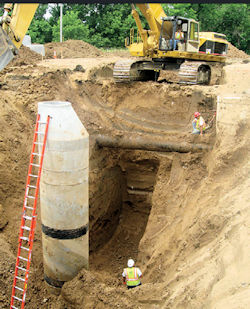The Five Workplace Hazard Categories
To help identify workplace hazards it's useful to categorize them into easy-to-remember categories. The first three categories represent hazardous physical conditions that, according to SAIF Corporation, account for only 3% of all workplace accidents. The fourth category describes behaviors in the workplace which may contribute up to 95% of all workplace accidents.
The last category, the system, contributes to both the hazardous conditions and unsafe behaviors. If you consider both the surface and root causes for accidents, the CSMS is ultimately responsible for most accidents in the workplace.
- Materials: Hazardous materials include hazardous:
- Liquid and solid chemicals such as acids, bases, solvents, and explosives. The hazard communication program is designed to communicate the hazards of chemicals to employees, and to make sure they use safe work practices when working with them.
- Solids, such as metals, wood, and plastics. Raw materials used to manufacture products are usually bought in large quantities and can cause injuries or fatalities in many ways.
- Gases, such as hydrogen sulfide and methane. Gas may be extremely hazardous if leaked into the atmosphere. Employees should know the signs and symptoms related to hazardous gases in the workplace.
- Equipment: This area includes machinery and tools used to produce or process goods. These examples all represent hazardous conditions in the workplace. Hazardous equipment includes machinery and tools.
- Environment: This area includes facility design, hazardous atmospheres, temperature, noise, factors that cause stress, etc. Are there areas in your workplace that are too hot, cold, dusty, dirty, messy, wet, etc. Is it too noisy, or are dangerous gases, vapors, liquids, fumes, etc., present?
- People: This area includes unsafe employee behaviors at all levels in the organization such as taking short cuts, not using personal protective equipment, and otherwise ignoring safety rules.
- System: Every company has, to some degree, a CSMS. It's good to think of the "state" of the CSMS as a condition. For instance, management may develop and implement ineffective policies, procedures and safety rules. A flawed CSMS is a systemic hazardous condition because it could increase the number accidents.
Note: To remember the five categories, just use the acronym "MEEPS" (Materials, Equipment, Environment, People, System).
Knowledge Check Choose the best answer for the question.
3-6. Which hazard category is ultimately responsible for most accidents?
You forgot to answer the question!

